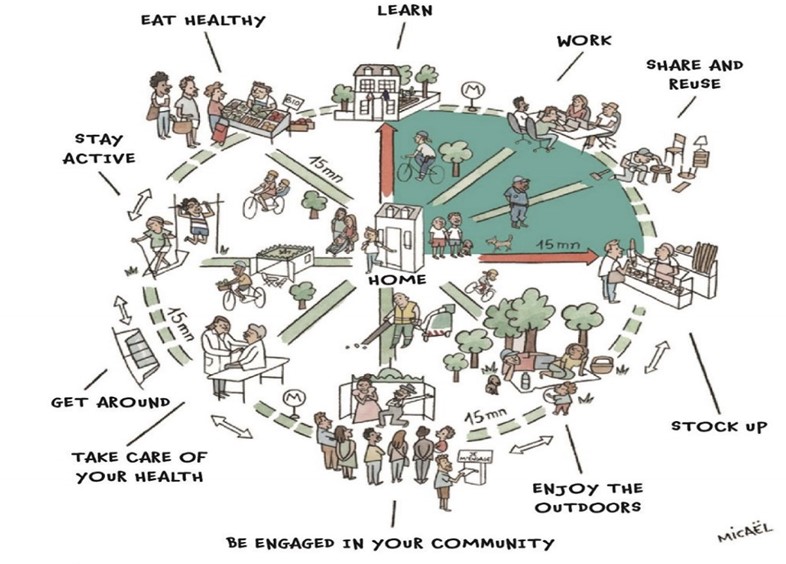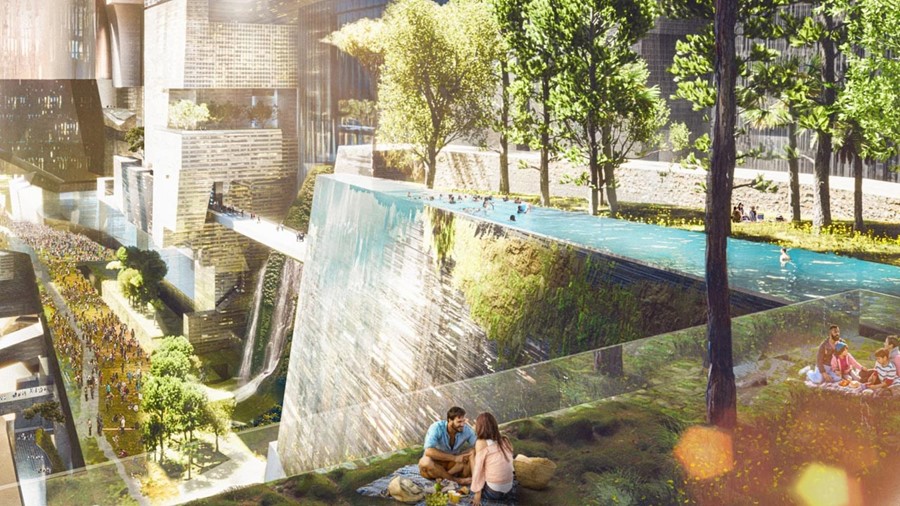TikTok conspiracy theorists say that the ‘15-minute city agenda’ is an attempt to usher in ‘climate lockdowns’ – supporters say it can help save a dying planet
It’s no secret that radical action is required if we want to meet our climate targets on schedule, and reach net zero global greenhouse gas emissions by 2050. For some, this presents itself as a challenge: how can we change the way we live, work, and travel to undo the damage of mass consumption and build a better planet? For some “free thinkers”, though, climate action represents an existential threat to our personal freedom, via schemes initiated by a shadowy global elite.
The latest of these conspiracy theories? The “15-minute city agenda”: a secret plan to lock us up inside small neighbourhoods, where everything we need is within a 15-minute walk and we’re not allowed to leave. According to right-wing conspiracists, the foundations have already been laid in Oxford, which, they say, is planning to impose “climate lockdowns” on residents by 2024.
One of these conspiracy theorists is far-right commentator Katie Hopkins – before hearing about 15-minute cities, she hadn’t met a strictly-enforced border she didn’t like – who recently released a fearmongering video about Oxford’s plans. “This is not by chance,” she says, suggesting that the 15-minute city is part of a vast governmental trend of “coercive control”. Elsewhere, she draws parallels with COVID regulations, which she’s previously called “the greatest hoax in human history”.
Since Hopkins’ rant was published (and despite Oxfordshire Country Council dispelling the rumours), misinformation about the 15-minute city has been spreading on platforms such as Twitter and TikTok. Below, we take a look at what the 15-minute city idea is all about – is it really something to be scared of, or could it be the path to a more sustainable future?
WHAT IS A 15-MINUTE CITY?
Essentially, a 15-minute city is just what it sounds like: a decentralised residential environment where everything you could need – work, food, health, education, and cultural facilities – is within a quarter of an hour by foot or by bike. That doesn’t mean you have to stay in your neighbourhood, but incentivises a return to “local living”, where commute times are shorter, people are less dependent on cars and, in theory, communities are tighter-knit.
WHERE DID THE IDEA COME FROM?
The 15-minute city isn’t a brand new idea. As an urban planning concept, it’s been around for some time, spearheaded by the award-winning scientist Carlos Moreno, who unveiled his 15-minute city model in 2016. It gained popularity when the Socialist politician and Paris mayor Anne Hidalgo made it a key element of her successful re-election campaign in 2020, promising more walkable communities with dedicated grocery shops, parks, cafes, health and sport facilities, workplaces, and schools within each arrondissement.
Similarly, the practice of “hyper proximity” for city dwellers has been introduced in cities such as Melbourne, Copenhagen, and Utrecht. Some even say that London was a 15-minute city in many respects pre-COVID (barring travel for work and some leisure activities), and the borough of Newham is actively pursuing 15-minute neighbourhoods.
Then, there’s large-scale, experimental projects like Saudi Arabia’s The Line, a planned, mirrored mega-city that’s supposed to run 170 kilometres long (but only 200 metres wide) through the desert. Set to accommodate 9 million people, The Line will apparently run on 100 per cent renewable energy, and all facilities will be accessible by a five-minute walk. Obviously, this is taking the concept to a whole new level, and it isn’t what most people are talking about when they talk about walkable cities.

AND OXFORD?
It’s generally good practice to assume the exact opposite of what Katie Hopkins says is true. In other words, no, Oxford is not planning to cut the city into six zones and lock residents in with electronic gates. Following a wave of abuse against staff and councillors last month, Oxfordshire Country Council put out a statement explaining that the proposal is actually about traffic filters, which will fine drivers using certain roads during peak hours to help develop a “more sustainable, reliable and inclusive transport system”. People will be able to walk, cycle, or ride public transport across the city at all times.
There are proposals for 15-minute neighbourhoods in Oxford, but these are separate from the traffic filters and not intended to restrict movement. “The 15-minute neighbourhoods proposal aims to ensure that every resident has all the essentials (shops, healthcare, parks) within a 15-minute walk of their home,” the statement clarifies. “They aim to support and add services, not restrict them.”
SO WHY ARE CONSPIRACY THEORISTS KICKING OFF?
“I’m going to connect some dots and I’m going to present you with some information,” begins one video from a TikTok psychic and podcaster. “What you do with this information is up to you.” This pretty much sums up the approach of all online conspiracy theorists: presenting loaded facts and information, and encouraging you, the viewer, to piece them together in your mind. It makes the viewer feel smart, and the creator gets to avoid any explicit claims that might get them in trouble.
Unsurprisingly, those “exposing” the “15-minute city agenda” online use language that gained traction during the pandemic to portray it as part of a conspiracy run by global elites to control the masses (see: references to the “climate mob” and the shadowy “people running the world”). At the end of the day, though, the narrative isn’t much different from the COVID conspiracies we’re all too familiar with, and is built to appeal to the same demographic.
Still buying into the “coercive control” story? You’re not alone; many people have taken to social media to share their fears about these “open air prisons”. Don’t worry, though, the TikTokers have some solutions. Namely, “do your own research” (AKA type conspiracy keywords into Google) and buy the cryptocurrencies they recommend. Not sure how that helps, but you do you!
THE PROS OF 15-MINUTE CITIES
Cars make up a disproportionate amount of the emissions on our roads, so it’s pretty obvious why any scheme designed to cut down their usage would be attractive if you’re worried about climate change. That’s not to mention the obvious health benefits of walking or cycling, and the time save of cutting down the commute.
Moreno’s 15-minute city model is also based on increased diversity – meaning both more multicultural neighbourhoods, and more development of mixed-use spaces designed to get people out of the house and more involved in the community. All of this, he says, is enabled by the increasingly online nature of our lives, which make working and meeting remotely easier for many people.
WHAT ABOUT THE CONS?
Needless to say, the 15-minute city isn’t without some valid criticisms. For one, existing experiments have mostly focused on Europe, where many cities were designed for the convenience of people rather than cars (since cars hadn’t been invented yet). Thanks to years of car-based development, of course, making all of these cities compatible with the 15-minute model is a lofty goal, but this issue is significantly worse in places like the US, where some cities have been built from the ground up with drivers in mind.
There’s also a concern that slicing cities up into smaller segments could encourage less mixing between different neighbourhoods, and exacerbate existing segregation along lines such as race or class. Others have criticised the lack of focus on accessibility, and the erasure of people who can’t walk or cycle everywhere they need to be.
These are all significant concerns to be taken into account if we want to develop cities where most of our day-to-day lives can be accessed by a simple quarter of an hour journey. Should we also be concerned that 15-minute cities are a giant conspiracy to enforce worldwide lockdowns? Probably not.
